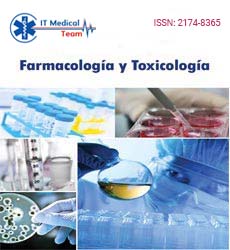Perspective - (2023) Volume 13, Issue 5
The role of healthy stem cells in toxicological research and drug screening
Manuel J. Gallardo Altamirano*
Department of Toxicology, University of Madri, Granada, Spain
*Correspondence:
Manuel J. Gallardo Altamirano, Department of Toxicology, University of Madri, Granada,
Spain,
Email:
Received: 04-Sep-2023, Manuscript No. ipft-23-14222;
Editor assigned: 07-Sep-2023, Pre QC No. P-14222;
Reviewed: 21-Sep-2023, QC No. Q-14222;
Revised: 03-Oct-0023, Manuscript No. R-14222;
Published:
19-Oct-2023, DOI: -
Introduction
Stem cells have emerged as a crucial player in the fields of
toxicological research and drug screening. These versatile
cells possess the unique ability to differentiate into various
cell types, making them invaluable tools in understanding
toxicological mechanisms and developing new therapeutic
approaches. In this comprehensive article, we will explore
the essential role of healthy stem cells in toxicological
research and drug screening, shedding light on their
potential to revolutionize the way we evaluate the safety
and efficacy of pharmaceutical compounds.
Description
Stem cells: An overview
Stem cells are undifferentiated cells with the remarkable
potential to develop into various specialized cell types,
such as neurons, muscle cells, or liver cells. They are
broadly categorized into two main types: Embryonic Stem
Cells (ESCs) and adult stem cells. Healthy stem cells are
primarily found in human embryos, where they play a
pivotal role in development, as well as in adult tissues,
contributing to regeneration and repair.
Toxicological research and stem cells
In vitro toxicology: Stem cells provide an in vitro platform for toxicological research, enabling scientists to
investigate the impact of toxic compounds on different
cell types without subjecting animals or humans to harm.
Human induced Pluripotent Stem Cells (iPSCs) have
gained significant attention in this regard, as they can be
reprogrammed from adult cells and represent a valuable
resource for studying drug toxicity.
Screening for teratogenicity: Understanding the
teratogenic potential of drugs and chemicals is crucial to
ensure the safety of pregnant women and their developing
fetuses. Healthy stem cells, specifically human Embryonic
Stem Cells (hESCs), have become essential tools for
evaluating teratogenicity by simulating the early stages of
human development.
Drug metabolism and toxicity: Stem cells can be
differentiated into hepatocyte-like cells, mimicking the
functions of the liver, which is a critical organ for drug
metabolism and toxicity. This model allows researchers to
assess how drugs are processed and identify potential toxic metabolites.
Drug screening and stem cells
Personalized medicine: Stem cells, particularly iPSCs,
can be derived from a patient's own cells, offering a
unique opportunity for personalized drug screening. This
approach ensures that drug candidates are effective and
safe for individual patients, ultimately leading to more
targeted and successful treatments.
Modeling disease: Stem cells can be used to generate
disease-specific cell lines, enabling researchers to better
understand the molecular mechanisms underlying various
diseases. These models facilitate drug screening and the
development of novel therapeutic strategies.
High-throughput screening: The automation and
scalability of stem cell-based assays make them suitable for
high-throughput drug screening. This approach
accelerates the drug discovery process by testing thousands
of compounds rapidly, potentially identifying new
candidates for further development.
Challenges and advances in stem cell-based
toxicological research and drug screening
Ethical concerns: The use of hESCs has raised ethical
concerns due to their derivation from human embryos.
This has prompted the development of alternative
methods, such as iPSCs, to mitigate these ethical issues.
Quality control: Ensuring the quality and consistency of
stem cell cultures is essential for reliable results. Advances
in culture techniques and quality control measures have
addressed this concern.
Differentiation protocols: Developing robust and
reproducible differentiation protocols to generate specific
cell types is an ongoing challenge in stem cell research.
Optimizing these protocols is critical for successful drug
screening.
Scaling-up: Scaling-up stem cell cultures for high
throughput applications remains a significant challenge.
Innovative bioprocessing and automation technologies are
being developed to meet this demand.
Case studies: Stem cells in toxicological
research and drug screening
Hepatocyte-like cells for drug metabolism: Stem
cell-derived hepatocyte-like cells have shown promise in predicting drug metabolism and potential toxicity. Recent
developments in this field have demonstrated their utility
in the pharmaceutical industry.
The future of stem cells in toxicological
research and drug screening
Advanced 3D models: The transition from twodimensional
cultures to three-dimensional organoids and
tissues offers a more physiologically relevant environment
for drug testing. These advanced models promise to better
predict in vivo responses to drugs and toxic compounds.
Gene editing techniques: The advent of gene editing
technologies like CRISPR-Cas9 has revolutionized stem
cell research. These techniques allow for precise genetic
modifications, making it possible to create disease-specific
cell lines and study the effects of specific genetic variants
on drug responses.
Organ-on-a-chip technology: Organ-on-a-chip devices
replicate the functions of entire organs, providing a
powerful tool for drug testing. Integrating stem cells into
these systems offers a microphysiological platform for
assessing drug effects with high fidelity.
AI and machine learning: Artificial intelligence and
machine learning are being employed to analyze the vast
amount of data generated by stem cell-based assays. These
technologies can identify subtle patterns and relationships
that may be missed by conventional analysis methods.
Conclusion
Healthy stem cells are revolutionizing toxicological
research and drug screening. They provide a versatile,
ethical and personalized approach to studying the effects
of pharmaceutical compounds and understanding disease
mechanisms. As technology continues to advance, the
integration of stem cells into these fields will likely lead to
safer and more effective drugs, ultimately benefiting
public health and medical progress.
In an ever-evolving landscape of science and technology,
the synergy between stem cells and toxicological research,
as well as drug screening, is a testament to the power of
interdisciplinary collaboration and innovative thinking.
With ethical concerns addressed, quality control ensured
and advanced techniques applied, stem cell-based
approaches hold the potential to transform the way we
evaluate the safety and efficacy of drugs, ushering in a new
era of healthcare and medicine.





